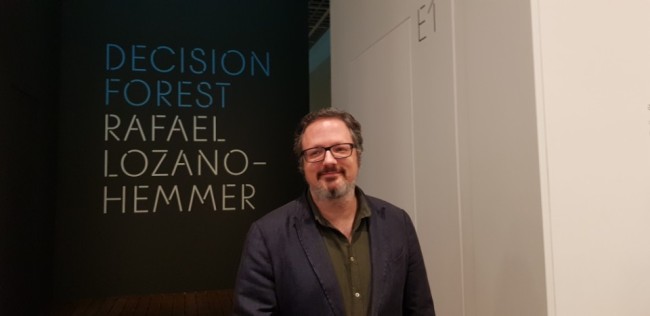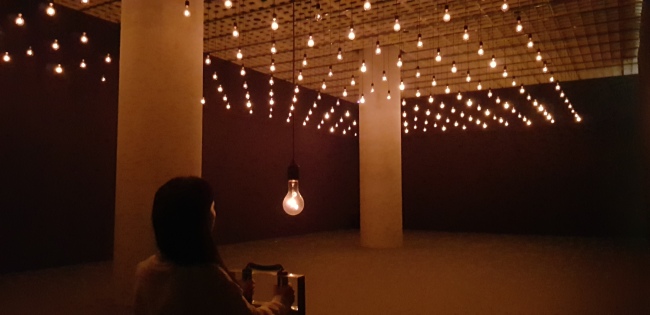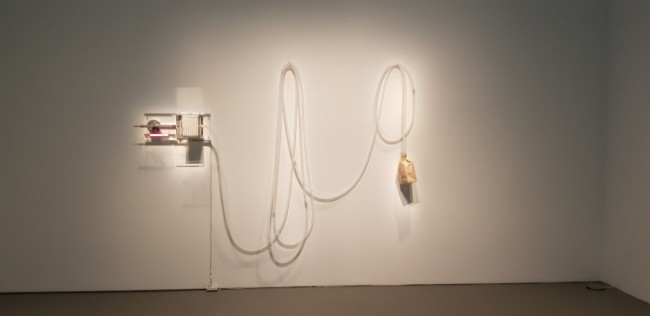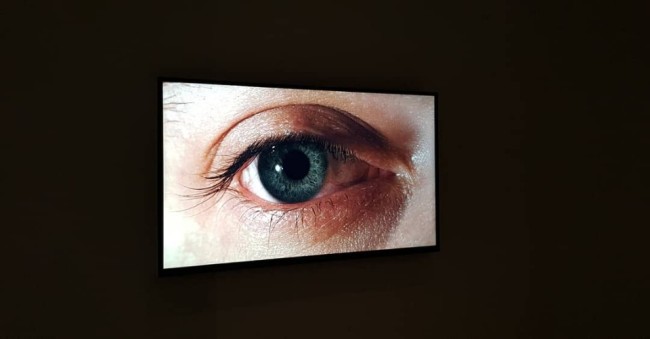Rafael Lozano-Hemmer‘s solo exhibition at Amorepacific Museum of Art is an exhibition that brings tangible technologies to the fore.
From his early works to his latest, Hemmer plays with various technologies, such as surveillance systems, voice recognition, fingerprint scanner and algorithms to allow the viewers to more easily relate to the technologies that have already become ubiquitous.
Numerous technologies have already become part of our language, and there is nothing new about his works, Hemmer said.

Artist Rafael Lozano-Hemmer (Shim Woo-hyun/The Korea Herald)
“I think of St. Augustine. The Apocalypse has already happened. I think that when my team and I are working with the stuff, it‘s not something about science fiction or a morality tale. It’s not a warning and it‘s not a prediction. It’s more of underlining and making tangible those forces of control and the ubiquity of those elements,” said Hemmer during an interview with The Korea Herald.
“Decision Forest” features a total of 29 works, including five that are being shown for the first time. One of the recent pieces on show for the first time is “Blue Sun,” a sphere-shaped display that simulates 25,580 Light Emitting Diode lights which reflects the sun’s turbulence, flares and spots recently observed by NASA. “Pareidolium” -- a low circular fountain that “draws” portraits of onlookers in mid-air with plumes of vapor that ascend from a water basin -- is also being shown for the first time.
“Nerd is my reality,” Hemmer said in talking about his love of adopting mathematics and contemporary technologies for his works. ”We (my team members) love algorithms. We honestly and genuinely adore a good algorithm. I think that there is beauty in them. There are behavior, emergence and patterns that can be created with this mathematics that I think all artists should be interested in them. Math is like a beautiful tool to make stuff. As nerds, our biggest interest is the collection of algorithm, so being able to understand them use them and nerd out with them.”
Hemmer invites the viewers to participate in works created with sophisticated technologies and ask them to join other participants, who came before them. “If there is nobody in the piece, the piece does not exist,” Hemmer said.

“Pulse Room” by Rafael Lozano-Hemmer, an interactive installation featuring 240 clear incandescent light bulbs. An interface placed on one side of the room has a sensor that detects the heart rate of participants. (Shim Woo-hyun/The Korea Herald)
Presence and absence coexist in the works by Lozano-Hemmer. Someone’s heartbeat or fingerprint left at the exhibition would still palpitate tomorrow, without the person‘s presence. The next day another person would come and listen to the heartbeat that he or she don’t know. They share the same space. “Absence and presence are not mutually exclusive. These are not two concepts. They share the same space,” Hemmer said.
While allowing the viewers to participate and have fun, Hemmer’s works also reflect critical theories as well as historical and cultural contexts.
Hemmer’s ”Last Breath“ -- unveiled at the Havana Biennial in 2012 -- is an installation work that plays with technology and cultural contexts. Designed to store and circulate the breath of respected Cuban singer Omara Portuondo, of the Buena Vista Social Club project, the piece magically captures -- or pretends to capture -- the breath of the revered singer in a brown paper bag. ”Last Breath“ is a biometric portrait of a cultural manifestation and also playful statement about death.

"Last Breath" by Rafael Lozano-Hemmer (Shim Woo-hyun/The Korea Herald)
Explaining that rations in Cuba came in brown paper bags, Hemmer said, “It’s a very important little bag in Cuba because it‘s where you eat. So we took the brown bag and also somebody whose voice everybody recognizes and admires. Then you try to do the impossible. You try to capture the essence of that singing and of that magic that this woman possesses. By sort of pretending that this magic is in her breath, and this can be kept (in the brown paper bad) is a designed fiction,” he said. Adding that the artist had a sense of humor about it, Hemmer quoted a 16th century French philosopher. “Montaigne said that ‘to philosophize is to learn how to die.’ Art making is the same,” said Hemmer.
Hemmer’s 1992 work “Surface Tension” makes a connection between French writer Georges Bataille‘s Surrealist text “The Solar Anus” and the smart bombs used in the first Gulf War.

"Surface Tension" by Rafael Lozano-Hemmer
”The particular moment in Bataille that interested me for ‘Surface Tension’ was the moment where the perception itself becomes aware. In the 1990s, there was the very first usage of smart bombs. The idea that the smart bombs had agency, their own perception and their own executive control over their destiny over where their target would be was this autonomy that I found in the Bataille’s texts,” said Hemmer.
In “Surface Tension,” the eye moves as if it has an awareness of itself. The supposed virtual, which is regarded to be behind the wall or display, is looking into our world. The observers (viewers) become the observed, added Hemmer.
Hemmer’s exhibition “Decision Forest” at APMA runs through Aug. 26.
By Shim Woo-hyun (ws@heraldcorp.com)









![[KH Explains] Hyundai's full hybrid edge to pay off amid slow transition to pure EVs](http://res.heraldm.com/phpwas/restmb_idxmake.php?idx=645&simg=/content/image/2024/04/18/20240418050645_0.jpg&u=20240419100350)